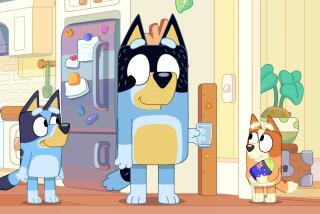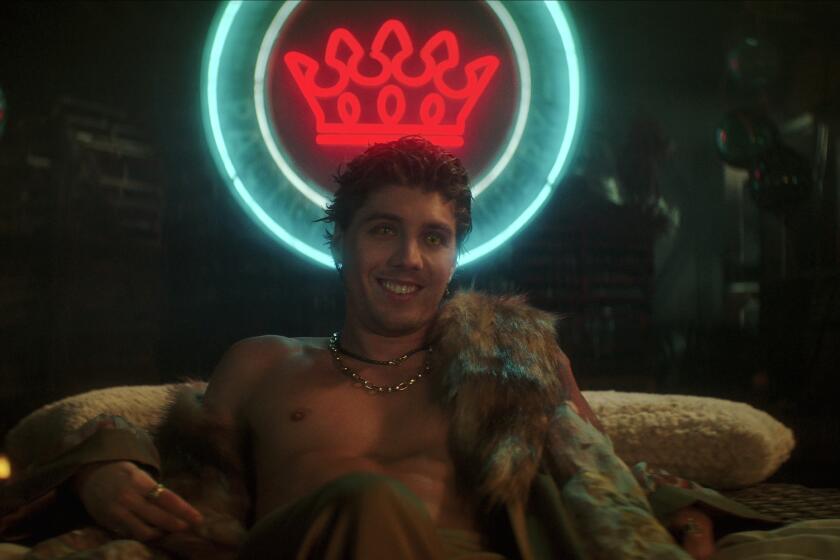Rebecca Sugar on finding that ‘Steven Universe feeling’ and the future of the verse
The snub-nosed, round face of an animated Steven Universe was framed on a monitor at the Cartoon Network’s Burbank recording studio. His signature curls and T-shirt were present, but instead of his usual starry-eyed grin, the cartoony mug of Steven was pensive. Beneath the screen, 18-year-old actor Zach Callison, voice of the titular character, started to sing.
Behind the glass of the sound booth, series creator Rebecca Sugar watched as the third season of her show came together. It was a fleeting behind-the-scenes glimpse at the creative forces behind “Steven Universe,” and the series was about to go deep. Callison’s voice was wistful, it was a sad song. A song about Steven’s mother, Rose Quartz, the beautiful and kind giant alien who gave up her physical form in order for Steven to be born. That may sound odd, but when “Steven Universe” gets serious, the audience listens.
Masked behind the colorful gemstone superhero crew there’s always something more, something real. A magical coming-of-age story, “Steven Universe” is known for tackling larger objects through its playful medium of animation. Episodes have addressed gender fluidity, unconventional families and now a boy learning more about the mother who sacrificed her life for his. But it always manages to deliver each message in a fun and creative way. Like Steven’s extended theme song for the series says: “We’ll win the fight and then go out for pizzas.”
The groundbreaking animated series kicked off its third season last week, with Steven and the Crystal Gems facing a familiar foe and stopping a long-dormant apocalyptic threat. But before this new debut, we spoke with Sugar on location about building this fantasy world adored by both kids and adults.
“Steven Universe” began back in 2013, centered around Steven Quartz Universe, a boy who is part human and part magical alien being known as a Gem, as he discovers more about himself, his loved ones and why they protect the world.
The first Cartoon Network series created by a woman, Steven is actually based on Sugar’s relationship with her real-life brother, Steven, and it is perhaps this personal connection that helps the fantasy series resonate with much of its audience.
Helping guide Steven through his journey in his mother’s absence are Garnet, Amethyst and Pearl, alien Gems and Steven’s surrogate parents who protect the planet while mentoring Steven as he learns to navigate his emerging powers. Like any parents, the Crystal Gems have often attempted to shield Steven from the complete truth about the past, only revealing aspects of their story as they felt it was appropriate (though they have not always been successful).
“We had always planned on having the world kind of open up in front of [Steven] because the entire show was supposed to be metaphorical to moving from childhood into adulthood and suddenly understanding what’s going on around you,” Sugar said.
Steven’s understanding of this universe parallels that of the audience. The correlation is deliberate.
“Just how much do you say to a child? It was interesting to write it and make that part of the show but also be how we felt about our audience,” said Sugar. “Because we were talking to kids who were growing up as we were writing the show and, I think, also guiding people through sort of what it takes to go deeper and understand someone.”
The slow reveal allows for the audience to develop their own connections with these characters as Steven’s relationship with them also strengthens, something very few shows populated with real-life people have success establishing.
“I think these characters, we think of them as people,” said Sugar. “And we find it very easy to follow these stories through by thinking about people instead of thinking about cartoon characters. And a lot of that sort of obvious cartoon language about what someone should or shouldn’t do, or what a character is supposed to be, really falls away when you start thinking about the actual people you know, the actual people you are.”
And that’s how ”Steven Universe” has successfully continued to push boundaries when it comes to depictions and understanding of gender. The Gems themselves, though they are presented as female, are in fact biologically genderless as their bodies are physical manifestations of magical space Gems. This set-up alone allows for the show to directly confront and reject established gender norms.
“Gender is such a huge component in so many cartoons,” said Sugar. “I mean, cartoons are made with that in mind. It’s just built into the DNA of cartoons: Who is it for? Right from the start I wanted to address that by turning a lot of those ideas not just on their head but just into the soup that they should be, because that’s just more realistic. And I really wanted to do it through cartoons because the semiotics of gender in cartoons have been so powerful of a force.”
In addition to defying categorizations about being a “boys’ show” or a “girls’ show,” “Steven Universe” uses its platform as a cartoon to convey expressly feminist messages regarding gender fluidity and same-sex relationships. Sugar and the “Steven Universe” crew are very much aware of how cartoons and messages in cartoons can affect fans and how cartoons themselves can affect a person’s understanding of the world.
“A lot of us are coming from a place where cartoons meant so much to us,” said Sugar. “And we’re really aware about how a cartoon can change who you are as a person and can also be this binding force between you and other people. It can forge connections with other people. We’re very conscious of that as we’re writing because it’s hard to separate a love of cartoons from just how we feel about everything.”
“It’s easy to learn from something that you care about,” Sugar continued. “Like really listen to someone who’s as interested in you as you are to them.”
One of the primary examples of “Steven Universe” breaking down expected gender norms is by a concept within the show called fusion. Fusion is the process in which two or more Gems combine to become a brand new entity, someone that is more than just a sum of their parts.
When Steven (accidentally) fuses with his human friend Connie and becomes Stevonnie for the first time, the other Gems are amazed only because fusing with a human should be impossible. While Stevonnie seems to intrigue both male and female human teenagers, Stevonnie’s gender itself is never questioned or discussed in any way.
Similarly, when it is revealed that the character Garnet is a fusion between Ruby and Sapphire, Steven’s reaction is starry-eyed excitement. That Garnet is the physical embodiment of Ruby and Sapphire’s love has been explicitly stated on the show — making their relationship one of the very few same-sex relationships depicted in an all-ages cartoon.
And if there’s ever resistance to some of these elements of the show, Sugar remains committed to the messages the show propels.
“When you have a message of love and tolerance it’s very hard for someone to say no, because it’s love and tolerance,” said Sugar. “Where I’ve stood throughout, when it comes to what I want to say and standing my ground, is that it will always be better to send this message of love and tolerance. It will always make sense.
“I think there are a lot of things that you’re just accustomed to never seeing, and if you just saw it more often you realize how natural it is,” Sugar said.
Beyond the colorful fantasy and space magic elements, “Steven Universe” is about relationships and understanding. And about forging connections — both between the characters on the show and among the audience.
“To me, making a piece of art is a relationship you have with the person that’s receiving that art,” explained Sugar. “And I’m really interested in talking directly to my audience and telling them how I feel and also having them receive that. The culture of the show is the show and it’s evolving with the people that are watching it, which is really exciting to me.”
“It means a lot to me that I get to communicate with so many people through the show and every other thing we get to make that’s a part of it,” said Sugar.
This is because from the show’s conception, “Steven Universe” was more that just a cartoon. It’s an entire world.
The universe is already expanding into different forms of media. “Steven Universe” has already branched out into books, comics and even a mobile game.
“Rebecca and the whole crew are very, very interested in these other platforms” said Rob Sorcher, chief content officer at Cartoon Network. “That’s why [the ‘Steven Universe’ game] ‘Attack the Light’ was so successful, because they collaborated at the beginning of that process and they were in it in a creative way. In the end, the creative wins.”
The creator explained that with each additional element added, the question evolved into what they could do to grow this world into something bigger. “Because it’s always felt bigger,” said Sugar.
And Sugar’s “Steven Universe” wish list is ever expanding. It includes action figures (a “dream come true” for Sugar) and maybe, one day, a full album.
“I’d love to do something more things with music,” Sugar said. Truthfully, she’s already halfway there; the show already had British pop star Estelle (who voices the character Garnet) sing on the series -- as well as guest spots from vocal heavyweights such as Aimee Mann, Nicki Minaj and Patti LuPone -- and Sugar herself sang the end credit theme, so why stop there? Sugar is in, “I’d love to make an album, that’s something I’m always hoping [for].”
No doubt a collection of tunes from the gemstones may bring many a tear from fans, but at least it will always end in pizza.
‘Steven Universe’
Where: Cartoon Network
When: 7 p.m. Thursday
Rating: TV-PG (may be unsuitable for young children)
Twitter: @tracycbrown
More to Read
The biggest entertainment stories
Get our big stories about Hollywood, film, television, music, arts, culture and more right in your inbox as soon as they publish.
You may occasionally receive promotional content from the Los Angeles Times.







